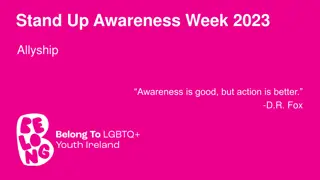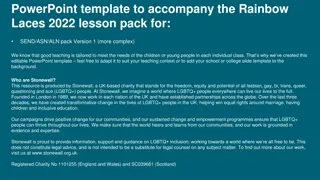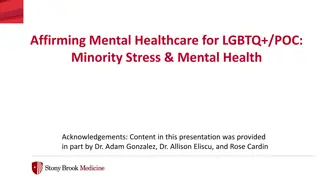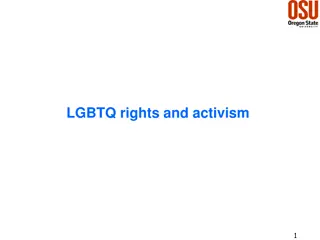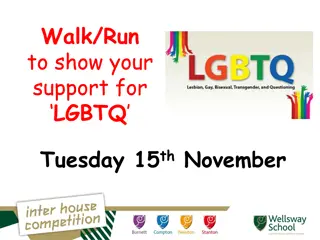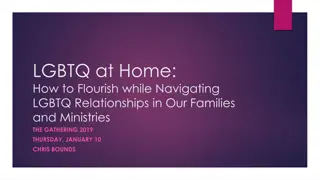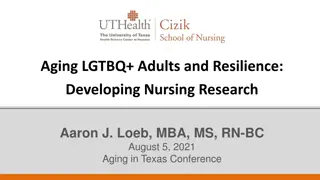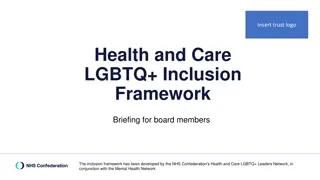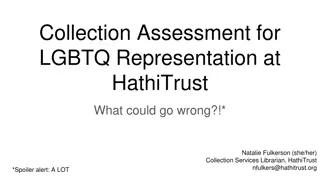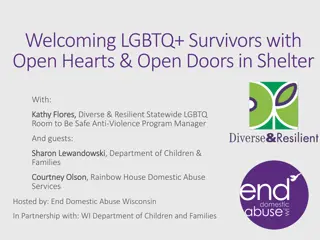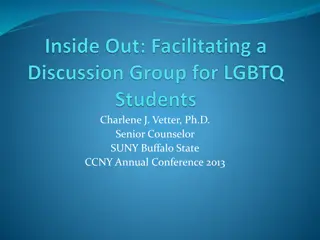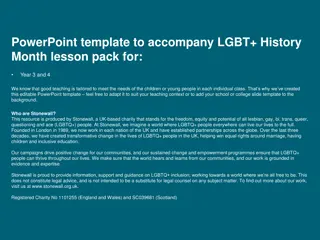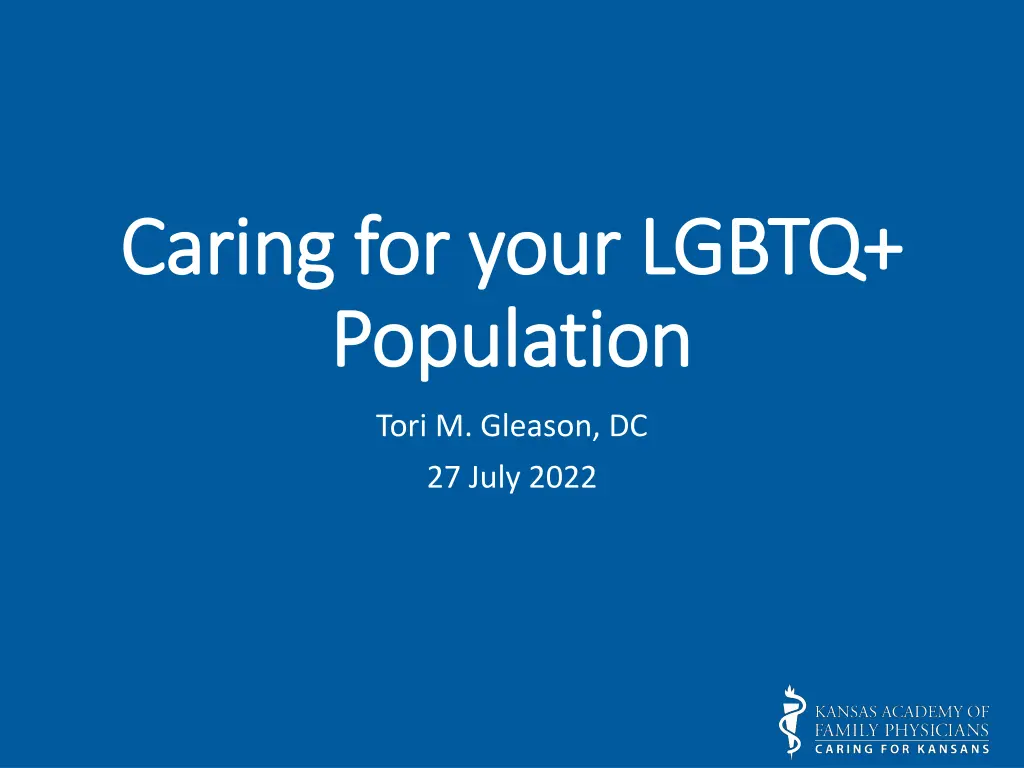
Addressing Health Inequities in LGBTQ+ Communities
Explore the population demographics and health inequities affecting LGBTQ+ individuals in Kansas, highlighting disparities in physical and mental health, general healthcare access, and specific challenges faced by transgender individuals. Learn about ongoing research initiatives and advocacy efforts aimed at improving care and support for this population.
Download Presentation

Please find below an Image/Link to download the presentation.
The content on the website is provided AS IS for your information and personal use only. It may not be sold, licensed, or shared on other websites without obtaining consent from the author. If you encounter any issues during the download, it is possible that the publisher has removed the file from their server.
You are allowed to download the files provided on this website for personal or commercial use, subject to the condition that they are used lawfully. All files are the property of their respective owners.
The content on the website is provided AS IS for your information and personal use only. It may not be sold, licensed, or shared on other websites without obtaining consent from the author.
E N D
Presentation Transcript
Caring for your LGBTQ+ Caring for your LGBTQ+ Population Population Tori M. Gleason, DC 27 July 2022
Tori M. Gleason, DC DC Palmer College of Chiropractic, Davenport, IA (2006) MPH KU School of Medicine, Wichita, KS (Anticipated 5/2023) Current Roles Clinical Analyst at LMH Health in Lawrence, KS Chiropractor in Olathe, KS Wichita LGBT Health Coalition, Board Member Outcare Health, Masonic Cancer Alliance Community Advisory Board KU Cancer Center, affiliate of Center for LGBTQ Research & Advocacy at the KU School of Social Welfare. Community Advisory Board: UCLA & KUMC Joint Study. Health System Stakeholder-Driven Assessment of Care and Support of Transgender and Gender Diverse Patient Population. Abstract Accepted: Beyond City Lights: Increasing Access to Rural-Based Care WPATH 2022. Montreal, Quebec, Canada, 09/16/2022. Research team looking at Transgender elder healthcare access and barriers. Research team looking at Assessment of Gender Affirming Surgery Complication Management in Emergency Medicine Physicians. Research team looking at gender affirming care with KU School of social welfare
Population Demographics in KS 92,000 Total LGBTQ+ Population (13+) in Kansas 4% of Workforce that is LGBTQ+ 56,000 Total LGBTQ+ Workers 33% of LGBTQ+ Adults (25+) Raising Children 12,400 Total population of patients identifying as Transgender (2022). https://williamsinstitute.law.ucla.edu/visualization/lgbt- stats/?topic=LGBT&area=20#density https://williamsinstitute.law.ucla.edu/wp- content/uploads/LGBT-ND-Protections-Update-Apr-2020.pdf https://data.census.gov/cedsci/table?q=dp03&tid=ACSDP1Y201 8.DP03
Health Health Inequities Inequities 2014 US Behavioral Risk Factor Surveillance System, 2014 19 states (n=151,456) Trans More days per month of Poor Physical Health More days per month of Poor Mental Health Higher Prevalence of Poor General Health Higher Prevalence of Myocardial infarction Higher Prevalence of Lack of Healthcare Provider Higher Prevalence of Not visiting a dentist in the last year Meyer, Brown, Herman, Reisner, Bockting, 2017
Health Health Inequities Inequities Poor self-rated general health HIV infection/other STI s Mental Health Conditions Substance Abuse Violence Disordered eating Preventative screening Lack of access to culturally competent care Homelessness, incarceration Health Inequities
Health Health Inequities Inequities Peltzmeier, Hughto White, Potter, Deutsch, Reisner, 2019 150 trans males 38.9% lifetime 10.1% in just past year alone Health Inequities 2-3x increase in odds of PTSD DEPRESSION GLOBAL PSYCHOLOGICAL DISTRESS
Differences trans v. cis youth Differences trans v. cis youth Health Inequities Reisner, Vetters, Leclerc et al. 2015
Suicide Rates among Transgender Suicide Rates among Transgender and GNC Adults and GNC Adults https://williamsinstitute.law.ucla.edu/wp- content/uploads/Suicidality-Transgender- Sep-2019.pdf Suicide attempts among trans men (46%) trans women (42%) were slightly higher than the full sample (41%). Prevalence of suicide attempts was highest among those who are: younger (18 to 24): 45%, multiracial (54%) , American Indian or Alaska Native (56%), lower levels of educational attainment (high school or less: 48-49%), lower annual household income (less than $10,000: 54%)
Suicide Rates among Transgender Suicide Rates among Transgender and GNC Adults and GNC Adults Respondents who experienced rejection by family and friends, discrimination, victimization, or violence had elevated prevalence of suicide attempts, such as those who experienced the following: Family chose not to speak/spend time with them: 57% Discrimination, victimization, or violence at school, at work, and when accessing health care Harassed or bullied at school (any level): 50-54% Experienced discrimination or harassment at work: 50-59% Doctor or health care provider refused to treat them: 60% Suffered physical or sexual violence: At work: 64-65% At school (any level): 63-78% Discrimination, victimization, or violence by law enforcement Disrespected or harassed by law enforcement officers: 57-61% Suffered physical or sexual violence: By law enforcement officers: 60-70 Experienced homelessness: 69% https://williamsinstitute.law.ucla.edu/wp-content/uploads/Suicidality-Transgender-Sep-2019.pdf
How Comfortable are Primary Care How Comfortable are Primary Care Providers? Providers? 140 respondents Mean age 39.7 52% resident physicians 75% ever met a transgender person 53% treated a transgender patient in the last 5 years Empathy scale (1-7) mean 5.4 Transphobia scale (1-7) mean 3.2 Adjusted odds of being willing to provide routine care decreased with age (adjusted odds ratio [aOR] = 0.89, P =.019) Odds of being willing to provide Pap tests were higher for family physicians than internists and those who had met a transgender and lower among those with higher transphobia scores. Medical education should address professional and personal factors related to caring for the transgender population to increase access. Shires et al Annals of Family Medicine 2018
How Comfortable are Endocrinologists How Comfortable are Endocrinologists taking care of patients that are trans? taking care of patients that are trans? Irwig Endocrine Practice 2016 Davidge-Pitts et al Endocrine Practice 2018 Survey of endocrinologists: (80 AACE attendees) 19-item paper survey was administered to 80 conference attendees 11% rated themselves as competent in transgender care 5% answered questions correctly 197 fellows 95.9% said training in transgender health is important 58.9% reported inclusion of dedicated transgender content in their training programs. Those with education were more likely to be confident in treating patients with hormone therapy (P<0.001 and p<0.0001, respectively) Fellows wanted: lectures from visiting professors (70.3%) Participation in elective rotations (62.1%) Online training modules (57.9%) Attendance at meetings with transgender topics (57.4%) CONCLUSION OF STUDY: Transgender health education of U.S. endocrinology fellows is suboptimal. Participation in a case-based session significantly increased the comfort level of endocrinology fellows in key areas of transgender health
Are Patients going to get angry about your SO/GI hx questions A study of 301 randomly selected patients from four racially and geographically diverse U.S. health centers found high acceptability by patients of routine SO/GI data collection: most expressed believing the questions are important and reported they would answer these again in the future (Cahill, et al., 2014). 78% of clinicians nationally believe patients would refuse to provide sexual orientation, however only 10% of patients say they would refuse to provide sexual orientation (Haider, et al., 2017). No difference in patient attitudes toward registration forms that include SOGI questions vs. forms that do not; only 3% of patients reported being distressed, upset or offended by SOGI questions (Rullo, et al., 2018)
Recommendation for Health Care Recommendation for Health Care Providers on LGBTQ+ pop Providers on LGBTQ+ pop Goal 1: Health providers understand the unique experiences faced by LGBTQ individuals and the community as a whole; patients should not have to educate their providers. Providers seek out and complete continuing education and training regarding the specific experiences and disparities that exist within the LGBTQ community. Providers partner with the LGBTQ community to continually assess needs, uncover gaps in service, and identify areas for improvement. Providers complete implicit bias training and use consistent self-reflection techniques to understand how bias impacts patient care.
Recommendation for Health Care Recommendation for Health Care Providers on LGBTQ+ pop Providers on LGBTQ+ pop Goal 2: Health care professionals and staff provide culturally-responsive and clinically-competent care that meets the needs of LGBTQ patients. Providers create an inclusive and explicitly welcoming environment for LGBTQ patients and their families, including comprehensive training of all staff. Providers seek out and participate in LGBTQ-inclusive networks, as well as communicate their availability to the LGBTQ community. Providers educate all patients on the importance of their sexual orientation and gender identity to their overall health. Providers use inclusive language (e.g. gender inclusive terms and gender pronouns), ask about sexual orientation, gender identity, sex assigned at birth, relationship status, and family structure, and conduct appropriate anatomical screens based on such information. Providers modify enrollment and data collection forms to include sexual orientation, gender identity, gender pronouns, sex assigned at birth, and relationship status, inclusive of the LGBTQ patients and family units, and ensure all staff are trained on such methods. Providers ensure organizational non-discrimination policies include sexual orientation, gender identity, and expression.
Recommendation for Health Care Recommendation for Health Care Providers on LGBTQ+ pop Providers on LGBTQ+ pop Goal 3: Educate and advocate on all levels within policy and health systems in order to improve LGBTQ health outcomes. Providers advocate on behalf of patients accessing LGBTQ-specific care -including gender- affirming care - which includes, but is not limited to, navigating prior authorization processes and appealing insurance coverage denials. Providers engage in public policy and advocacy to change systems and improve health outcomes within the LGBTQ community.
Toolbox for physicians w/ trans Toolbox for physicians w/ trans pop pop Be sensitive of language used with all patients Ask patients the name and pronouns they use Don t assume a patient wants to medically affirm their gender Don t assume a patient s sexual orientation based on gender identity Assess for social Stressors Provide contextualized healthcare grounded in lived experiences of transgender and nonbinary patients.
Implementation Implementation Reach out to champions that have done this already and ask. You re going to make mistakes. Apologize and don t dwell on them. Action items for your clinic/health system Health Equity Action Team (HEAT) Community Advisory Panel (CAP) Inclusion, Equity & Diversity Team (ID&E)
Sign up for the rest of the series Sign up for the rest of the series 08/03/22 08/10/22 08/17/22 A history of systemic bias in Medicine. Jason Glenn, Ph.D. The importance of communication in treating people with disabilities. Sheila Styron, ACTCP Deconstructing Bias: Allyship Maria Alonso Luaces, Ph.D.
Upcoming Learning Opportunities National LGBTQIA+ Health Education https://www.lgbtqiahealtheducation.org/ 08/04/2022 Eating Disorders in the Transgender Community CU School of Medicine; 1:00-2:00pm CDT https://connect.echocolorado.org/Series/Registration/203 (No Cost) 09/01/2022 Alternative Anti-Androgens in Transfeminine Patients CU School of Medicine; 1:00-2:00pm CDT https://connect.echocolorado.org/Series/Registration/203 (No Cost) 09/16/2022 09/20/2022 World Professional Association for Transgender Health (WPATH) 27th Scientific Symposium https://www.wpath.org/27th-Symposium-Info 10/06/2022 Management of Ongoing Bleeding in Transmasculine Patients CU School of Medicine; 1:00-2:00pm CDT https://connect.echocolorado.org/Series/Registration/203 (No Cost) 10/13/2022 10/16/2022 8th annual Advancing Excellence in Transgender Health Conference: A course for the Whole Care Team Harvard Medical School Live & Virtual https://web.cvent.com/event/76c87c9d-51d1-41d5-8ccb- e1e69dc80a42/summary
Questions? Tori Gleason, DC Clinical Analyst, LMH Health (Lawrence, KS) Tori.Gleason@lmh.org or tgleason@kumc.edu 785-821-1409 (cell)
References / Resources https://williamsinstitute.law.ucla.edu/visualization/lgbt-stats/?topic=LGBT&area=20#density https://williamsinstitute.law.ucla.edu/wp-content/uploads/LGBT-ND-Protections-Update-Apr-2020.pdf https://data.census.gov/cedsci/table?q=dp03&tid=ACSDP1Y2018.DP03 NTDS_Report.pdf (transequality.org)




